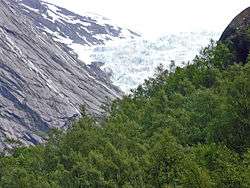Jens Esmark

Jens Esmark (31 January 1763 – 26 January 1839) was a Danish-Norwegian professor of mineralogy who contributed to many of the initial discoveries and conceptual analyses of glaciers, specifically the concept that glaciers had covered larger areas in the past.[1]
Biography
Jens Esmark was born in Houlbjerg in Århus, Denmark. Esmark moved to Norway to the silver mining community of Kongsberg. He studied at the local mining academy. He completed his subsequent studies in Copenhagen and was accepted as a surveyor. Starting in 1797, Esmark was employed as a lecturer in mineralogy at the Kongsberg Mining Academy. In 1814, Esmark became Norway's first professor of geology as a professor of geology at the University of Oslo, and was described as "a pioneer in glacial geology", by professor of Quaternary geology and Glaciology Bjørn G. Andersen.[2]
In August 1801 Esmark was the first person to ascend Snøhetta, highest in the mountain range Dovrefjell in southern Norway.[3] The same year he led the first expedition to Bitihorn, a small mountain in the southernmost outskirts of Jotunheimen, Norway. In 1810 he was the first person to ascend the mountain Gaustatoppen in Telemark, Norway.
Professor Esmark theorized in 1824 that glaciers had once been larger and thicker and had covered much of Norway and the adjacent sea floor.[4] He also attributed erratic boulders and moraines to glacial transportation and deposition. He first recognized glaciers as a powerful agent of erosion that had carved the Norwegian fjords.[5]
Professor Esmark was also an important figure in the history and cultural heritage of mineralogy. He introduced norite the name for which was derived from the Norwegian name for Norway, Norge.[6]
On the island of Løvøya, Norway, his son, Hans Morten Thrane Esmark, found the first specimens of a black mineral, thorite, from which the element thorium is derived.[7] His son also provided him with a new mineral which he found in Arendal, Norway. In 1806 he named datolite, from the Greek word meaning "to divide". This was a reference to the granular structure of the first specimens studied.[8]
In 1825, Professor Esmark was elected a member of the Royal Swedish Academy of Sciences. In 1832, he was Knighted in the Swedish Order of Vasa.
Selected works
- Kurze Beschreibung einer mineralogischen Reise durch Ungarn, Siebenbürgen und das Bannat ( Freyberg, 1798)
- Reise fra Christiania til Trondhjem (1829)
Notes
- ↑ Jens Esmark (Store norske leksikon)
- ↑ Andersen, Bjørn G. (1992). "Jens Esmark—a pioneer in glacial geology". 21 (1). Boreas: 97–102.
- ↑ "Snøhetta". Archived from the original on October 31, 2007. Retrieved 2007-01-18.
- ↑ Burroughs, William J. (2005). Climate Change in Prehistory: The End of the Reign of Chaos. Cambridge: Cambridge University Press. pp. 22–24. ISBN 978-0-521-82409-5.
- ↑ "Birth of the Glacial Theory". academic.emporia.edu. Retrieved 2007-01-18.
- ↑ "Publications related to the history and cultural heritage of mineralogy". Retrieved 2007-01-18.
- ↑ "Thorium". BBC.co. Retrieved 2007-01-18.
- ↑ "Datolite". The Gemology Project. Retrieved 2007-01-18.
References
- Cunningham, F.F. (1990) James David Forbes: Pioneer Scottish glaciologist (Edinburgh: Scottish Academic Press)
- Burroughs, William James (2005) Climate Change in Prehistory: The End of the Reign of Chaos (Cambridge University Press) ISBN 978-0-521-82409-5
- Hestmark, Geir 2009. “Her ligger Sneen evig.” – Da Dovre falt – for Esmarks barometer. Historisk Tidsskrift 88: 231-249.
- Hestmark, Geir 2012. To discover, yes, but top publish...? Jens Esmark, datolite..and thulite. Norwegian Mining Museum, Publication No. 49: 45-52.
External links
-
 Works written by or about Jens Esmark at Wikisource
Works written by or about Jens Esmark at Wikisource - Forsand
- Photos of Datolite
- Thorium: History